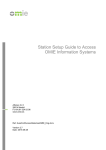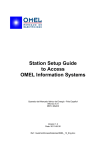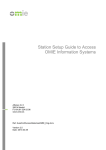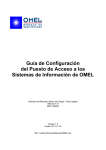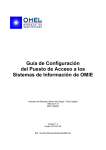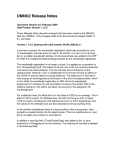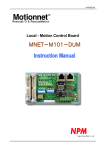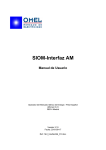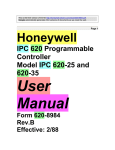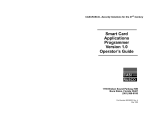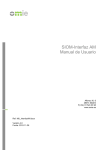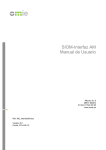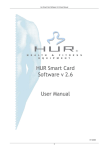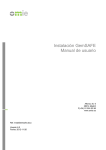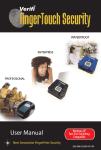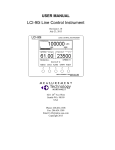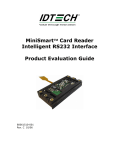Download Station Setup Guide to Access OMIE Information Systems
Transcript
Station Setup Guide to Access
OMIE Information Systems
Alfonso XI, 6
28014 Madrid
F(+34) 91 524 03 96
www.omie.es
Ref. GuiaConfAccesoSistemasOMIE_Eng.docx
Version 2.1
Date: 2012-11-23
ÍNDICE
1
INTRODUCTION
3
2
PRE-REQUISITES
4
2.1
2.2
2.2.1
2.2.2
2.3
2.4
2.5
2.6
2.6.1
2.6.2
2.7
MAIN COMPONENTS AND VERSIONS
OPERATING SYSTEM
Screen setup
User Account Control
MICROSOFT INTERNET EXPLORER
JAVA VIRTUAL MACHINE FROM SUN
CARD READER INSTALLATION (ONLY FOR SMARTCARD CERTIFICATES)
USER CERTIFICATE REGISTRATION
Smartcard certificates
Software certificates
SIGNING ENTITY CERTIFICATE (OMIE ROOT CA CERTIFICATE)
4
5
5
5
6
9
11
11
11
13
15
3
AUTOMATIC INSTALLATION OF COMPONENTS
19
3.1
3.2
FIRST SYSTEM ACCESS
COMPONENTS UPDATE
19
23
4
SIGNATURE APPLET SETUP
24
5
FREQUENT PROBLEMS
26
5.1
5.2
5.3
5.4
5.5
ERROR MESSAGES APPEAR DURING INSTALLATION OF APPLETS
THE CARD PIN REQUEST TAKES A LONG TIME, OR THE BROWSER STALLS
“SECURITY ALERT” APPEARS ON LOGGING ONTO THE SYSTEM
THE SERVER DOES NOT ALLOW ACCESS TO THE SYSTEM
USE OF NAMESPACES IN XML DOCUMENTS (ONLY FOR ELECTRICITY MARKET
WEBSITE)
BLOCKING POP-UP WINDOWS
PROBLEMS WHEN DOWNLOADING COMPONENTS
FILE DOWNLOAD WARNING
PROBLEMS STARTING DOWNLOAD CENTER (ONLY FOR THE ELECTRICITY MARKET
WEBSITE)
PROBLEMS LOGGING ONTO THE W EB WITH NO JAVA INSTALLED
INCORRECT INSTALLATION OF OMEL ROOT CA CERTIFICATE
TWO W INDOWS OF THE DOWNLOAD CENTER ARE OPENED (ONLY FOR THE
ELECTRICITY MARKET WEBSITE)
26
27
28
28
5.6
5.7
5.8
5.9
5.10
5.11
5.12
Version 2.1
GuiaConfAccesoSistemasOMIE_Eng.docx
29
30
32
33
33
34
35
36
Pag. 2 de 36
1 INTRODUCTION
This guide describes the requirements for a client station to access OMIE Information Systems
and the necessary steps to start using the Web environments of the Electricity Market’s
Information System (hereinafter SIOM).
SIOM websites require Microsoft Internet Explorer browser and Sun’s Plug-in for running Java
components in the browser. Likewise, it is required to access using user certificates provided by
OMIE, either on smartcard or file (software certificate) support
There are no sections on the installation of hardware and standard software components, such
as the operating system, browser, or the hardware installation of the card reader. However, the
following paragraphs outline the necessary requirements as regards versions and some setup
details for the same to ensure proper working. For the basic installation of products, you should
consult their installation or help guides.
Versión 2.1
GuiaConfAccesoSistemasOMIE.docx
Pág. 3 de 36
2 PRE-REQUISITES
2.1
Main components and versions
The main software and hardware components required for the SIOM Web Sites are the
following:
Operating system:
o
Windows XP Home / Professional, SP2 or higher
o
Windows 7 (recommended)
Microsoft Internet Explorer browser
o
Versions 8 (with disabled compatibility view) and 9 (recommended), both for 32 bits
o
Auctions Web sites allow also Internet Explorer 7
Sun Java Virtual Machine
o
Versions 1.6.0 update 30 ó higher (except versions 1.7)
o
Auctions Web sites allow also versions 1.6.0 from update 10
In any case, the most up to date information about the latest recommended and approved
version of the Virtual Machine for access to the SIOM websites is located on OMIE Public
website (www.omie.es), on section “Technical documentation” inside “Trading System”.
Card reader (only for smartcard certificates)
User certificate registration
OMIE Root CA Certificate
The following sections describe in more detail these requisites and additional configuration
options.
Version 2.1
GuiaConfAccesoSistemasOMIE_Eng.docx
Pag. 4 de 36
2.2
Operating System
2.2.1
Screen setup
The website was designed for an optimal setup of 1280x1024 pixels and 65536 colours.
2.2.2
User Account Control
Using Windows 7, it is necessary to launch the web browser as administrator or disable the
security windows module “UAC” (User Account Control) for the first access to system for letting
the installation of Java applets on the user station.
To disable UAC, go to:
Control Panel User Accounts User account control settings
In this screen slide the slider bar to the lowest value (towards Never Notify), with description
showing “Never notify me.”
This is the required setup for the first web access components installation. Once finished the
installation and the first system access, UAC can be enabled again. It can be necessary to
disable UAC again (see chapter 3.2) in case of updating the installed components,
Note: Screenshots of this document are taken on a Windows 7 system. For Windows XP systems
follow the corresponding steps on that operation system.
Version 2.1
GuiaConfAccesoSistemasOMIE_Eng.docx
Pag. 5 de 36
2.3
Microsoft Internet Explorer
On Windows 7, 32 bits version of Internet Explorer web browser must be used.
On the other hand, given that the SSL (Secure Sockets Layer) protocol with strong encryption
(128 or 256 bits) is used to establish a session, the browser must support this level of
encryption. To check the level of encryption supported by the browser, just press the menu
Other configuration options to take into consideration are the following:
Allow downloading of the signed Applets
The browser is required to permit downloading of the signed Applets. To do so, you just
have to select “Medium-high” for the security level in the “Internet” zone, which is the
default security level setting on installing Internet Explorer. To check this setting, follow
these steps from the browser menu:
Tools Internet options Security
From this screen, select the “Internet” zone and activate the “Medium-high” security
level. In the event that the OMIE Website (“*.omie.es”) has been included in the “Trusted
sites” zone, this zone must have “Medium” security level. In the case of the Electricity
Market Web, the site “*.emergenciaomie.es” must also be included as a trusted site.
This security level is sufficient for most safe Web servers, and implies that downloaded
components can be executed, though always with user confirmation.
In case of having trouble entering the website, please check that the trusted sites
configuration includes at least the following:
o
Accessing SIOM and auctions websites: “*.omie.es”
o
Accessing SIOME (backup SIOM website): “*.emergenciaomie.es”
Version 2.1
GuiaConfAccesoSistemasOMIE_Eng.docx
Pag. 6 de 36
Allow the use of COOKIES
Your browser must support COOKIES (small elements of information that the server
stores in the client computer). The COOKIES of the OMIE Website Web interface are only
used to control an active session.
To allow the use of COOKIES, register the access URL in the “Trusted sites” zone, or
select a medium security setting (which is the browser’s default setting) for the internet
zone in:
Tools Internet options Privacy
Allow popup windows
The browser must not block the SIOM website popup windows, as the said windows
include the necessary functions for the correct working of the system. In the event that
tools have been installed that block popup windows (for example, MSN or Google bars),
or in the event that Windows XP SP2 (which adds privacy options allowing blocking of
popup windows) is being used, you will need to configure the said tools so that the SIOM
Web popup windows are not blocked.
As regards this particular aspect, you are recommended to disable Blocking pop-up
windows at least for all OMIE servers, by using the “*.omie.es” and “*.emergenciaomie.es”
masks and selecting low filter level (for further information, see section 5.6).
In Internet Explorer 8 you are recommended to maintain the browser’s default tab
settings, so that the popup windows always open in a new window. The said settings are
found in:
Tools Internet options General Tabs Settings
In Internet Explorer 9, disable ActiveX filtering
Using Internet Explorer 9, it is required that the ActiveX filtering is disabled. Please check
that this option is disabled on menu:
Tools ActiveX Filtering
Version 2.1
GuiaConfAccesoSistemasOMIE_Eng.docx
Pag. 7 de 36
Enable editing through Excel (only for access to the Market website)
If you wish to use the option for editing the content of bids through Excel (recommended
for stations from which the bids are sent), you will need to modify the default setting of the
“Medium” security level. At
Tools Internet options Security Internet
Click on “Custom level” and look for:
ActiveX controls and plug-ins
Initialize and script ActiveX controls not marked as safe for scripting.
()Prompt
Although the default option is “Disable”, you will need to mark “Prompt” or “Enable” in
order to be able to launch Excel from the browser. This is due to the fact that Windows
does not permit the Excel Active X (installed by Excel itself) to be marked as safe, as it
has given rise to virus problems in the past.
You are recommended to check the “Prompt” option (which implies that the browser
requests the user confirmation to run the Excel ActiveX).
For more information about the setup and working of the bid edit option through Excel,
read the 'Excel Bid Editing, User Manual'.
Minimum options review
For the case in which client security setup has already been customised due to the use of
other applications, or to corporate security policies, indicated below are the minimum
options, which must be activated for the correct use of the system (only the necessary
options are described, those not listed do not affect the application). These values will be
activated in the “Internet” zone, unless the OMIE Website has been included in one of the
other zones (local intranet, trusted sites, restricted sites), in which case they will be
activated in the corresponding zone.
Tools Internet options Security Internet
Scripting
Active scripting
() Enable
Scripting of Java applets
() Enable
ActiveX controls and plug-ins
Download signed ActiveX controls
()Prompt 1
Run ActiveX controls and plug-ins
() Enable
Generate scripts of ActiveX controls marked as safe for scripting
() Enable
Downloads
File download
() Enable2
As for advanced setup options, the following option must be selected:
Tools Internet options Advanced options
Security
[] Use SSL 3.0
1
2
Version 2.1
Necessary for downloading applets to the client on first accessing the application.
Necessary for downloading bids and other data to a file.
GuiaConfAccesoSistemasOMIE_Eng.docx
Pag. 8 de 36
2.4
Java Virtual Machine from Sun
OMIE’s website interface makes intensive use of executable components which are
downloaded from the web server. These components are Java programs, also known as
Applets, which have been previously signed by OMIE so that the browser can check their
authenticity to ensure that execution of the same does not lead to any security problem.
Because of that, you must install and activate the browser’s Java virtual machine (JVM, which is
the Applet execution environment. The required JVM is the one provided by Sun. The browser
uses the said virtual machine through an extension or Plug-in, which is installed together with
the JVM
To check if this JVM is installed, see if the “Java” option exists in the Windows Control Panel:
Version 2.1
GuiaConfAccesoSistemasOMIE_Eng.docx
Pag. 9 de 36
In the event that the said option is not available, you must install Sun JVM. To do so, log onto
the SIOM website and activate the download from there (see instructions below).
If a Sun JVM is already installed, to check its version, start the Java Control Panel, and click on
the “About” button:
If the version is not valid, update by removing the installed version and access OMIE’s website.
From there, and as described in Chapter 3, the correct JVM will automatically be installed,
without the need to previously download any version of the said virtual machine (in order to
carry out this installation, the user connected to the operating system is required to have the
necessary Administrator privileges).
The current version must be removed from the “Add or remove programs” option in the
Windows Control Panel, by selecting entry-J2SE Runtime Environment with the corresponding
version, and by clicking on Remove.
Chapter 3 describes the way to install the correct JVM from the OMIE website.
Note: Updating the JVM version can be carried out through the options available in the Update tab in
the Java Control Panel, or by downloading the latest version from the Sun website. However, in order
to avoid installing versions which have not yet been certified for use in SIOM, you are recommended
to carry out the installation by accessing the website with no virtual machine installed.
Version 2.1
GuiaConfAccesoSistemasOMIE_Eng.docx
Pag. 10 de 36
2.5
Card reader installation (Only for smartcard certificates)
In order to access SIOM Websites, a X.509 personal security certificate it’s needed, which
OMIE issues on a Gemplus smart card or file. In case of using a certificate issued in a
smartcard a smart card reader is needed.
The user can use any standard PC/SC compatible reader, in which Gemplus software must be
installed. The 'Gemplus software installation guide', which is provided as a separate
document, outlines the steps to be followed. The card reader must be previously installed and
you must be able to use the security card with Internet Explorer in order to be able to follow the
steps listed below for setting up the station.
If you wish to install a GemPCTwin card reader, the specific drivers for this card reader will need
to be installed once the Gemplus software has been installed.
2.6
2.6.1
User certificate registration
Smartcard certificates
When using a new security card for the first time at a user station, keep in mind that you will
need to register with Windows the certificate stored in the card so that it can be used from
the browser (it is a requirement of Internet Explorer). In Windows XP this registration is carried
out automatically under certain conditions, although you are recommended to do it manually in
all cases in order to ensure the correct working with different users and profiles on the same
PC.
Use the Card reader software to register a certificate, as follows:
Insert the card in the reader and start the GemSAFE Toolbox program from Windows:
Click on Card contents Certificates (Contenido tarjeta Certificados) and enter the card PIN
in the NIP Code section. Click on the Start session button to start the session:
Version 2.1
GuiaConfAccesoSistemasOMIE_Eng.docx
Pag. 11 de 36
To register the certificate, select the card icon and click on Register all (Registrar todos):
The following screen will display after a few seconds indicating that the certificate has been
registered.
Click Accept (Aceptar) to finish the process of registration of the certificate.
Version 2.1
GuiaConfAccesoSistemasOMIE_Eng.docx
Pag. 12 de 36
2.6.2
Software certificates
File support certificates a.k.a. software certificates, are issued on “.p12” file (PKCS #12
standard). For registering issued software certificates, follow the next steps.
Download “.p12” file in an accessible location from the station where software certificate is going
to be registered. Select the file with double click (this process can be started from the web
browser too in “Tools / Internet options / Content / Certificates / Import”)
Follow the given steps showing in the screen using the default options until this window is
shown:
Type OMIE’s issued private key password and check “Enable strong private key protection” box.
Follow with default options until this window is shown:
Version 2.1
GuiaConfAccesoSistemasOMIE_Eng.docx
Pag. 13 de 36
Click on “Set security level…”
In this window, “Medium” or “High” level can be selected for setting up system behaviour when
using certificate to SIOM access or information sent signing. Selecting “Medium” browser only
will show a confirmation window when private key access is needed. Selecting “High”, browser
will request the password for the private key access.
It’s recommended to select “High” level and choose a password as a PIN for system access and
data sent signing. Doing this, this window will appear after clicking “Next” for typing and confirm
the chosen password:
Alter clicking on “Finish” and “OK”, this window will mean the end of the process:
Version 2.1
GuiaConfAccesoSistemasOMIE_Eng.docx
Pag. 14 de 36
2.7
Signing entity certificate (OMIE Root CA Certificate)
An indispensable requisite for the correct installation of components typical of SIOM Webs is
having the OMEL CA Signing Entity certificate installed in the browser. The steps for installing
the OMEL CA certificate are outlined below.
When accessing the system for the first time, or whenever the said certificate is not installed,
the following warning screen will display. At the said screen, click on “Continue to this
website”:
Then click on “Certificate error” which displays on the right hand side of the address bar:
This window will display. Click on “View certificates”:
Version 2.1
GuiaConfAccesoSistemasOMIE_Eng.docx
Pag. 15 de 36
In the next window, click on the third tab (Certification Path). Select the tree root (omelCA) and
click on “View Certificate”:
At the next window, click on “Install certificate”:
Version 2.1
GuiaConfAccesoSistemasOMIE_Eng.docx
Pag. 16 de 36
Click on “Next”:
At the next window, check option “Place all certificates in the following store” and click on
“Browse”
At the next window, select “Trusted Root Certification Authorities” and click on “OK”.
Version 2.1
GuiaConfAccesoSistemasOMIE_Eng.docx
Pag. 17 de 36
On the previous window click on “Next”, and once the next window opens, select “Finish”:
Then the next window opens where you click on “Yes” to finish the certificate import:
The browser confirms the correct installation of the certificate. Click on “OK”:
Version 2.1
GuiaConfAccesoSistemasOMIE_Eng.docx
Pag. 18 de 36
3 AUTOMATIC INSTALLATION OF COMPONENTS
3.1
First system access
On accessing the system for the first time, the necessary components or applets are installed in
the local hard drive. For correct installation, on this first occasion you will need to be the
computer’s local administrator or if using Windows 7, disable UAC (see chapter 2.2)
The steps for installing the components are outlined below:
Access without an installed Java Virtual Machine
Go to the website (for instance, www.mercado.omie.es). At this page, the JVM activates
verification and downloading of the system’s Applets. However, if no version of Sun’s JVM
has been installed, a window will display asking whether you wish to install the latest
supported version (the shots show version 1.6.0_30)
From Internet Explorer 8, the installation process starts from a message that displays on
the upper part of the browser, indicating whether that it is necessary to install a new
“ActiveX control” (in Explorer 8), which is the JVM itself, or that there is certain blocked
content (in Explorer 9).
After clicking on “Install” or “Display Blocked Content” (depending on the browser), the
installation process of the same will start, as described below. In order to complete this
installation process, the user connected to the operating system requires Administrator
privileges.
Version 2.1
GuiaConfAccesoSistemasOMIE_Eng.docx
Pag. 19 de 36
Several installation screens display until the process has been completed:
Note: If you are using an installer other than the one that is run on accessing the SIOM Website,
the option to install the so-called “Google bar” may display. In the event of its installation, keep in
mind that it could cause interference in the control of opening pop-up windows from the SIOM
application.
To check the version of the recently installed JVM, you can once again consult the option
“About” in the Java Control Panel:
Version 2.1
GuiaConfAccesoSistemasOMIE_Eng.docx
Pag. 20 de 36
In addition, due to the possibility of Sun releasing a new version of JRE which has not yet
been certified for use in SIOM, you are recommended to disable the automatic update of
the JVM. This is configured by disabling the next box in the Java Control Panel:
Version 2.1
GuiaConfAccesoSistemasOMIE_Eng.docx
Pag. 21 de 36
Installation of system Applets
Then the verification and downloading of the system’s Applets is enabled. During
download, you cannot enter the system. To confirm the download and execution of the
applets, several screens similar to the following will display.
In all cases, click OK, until all the packages have been installed. In the event of a security
warning, mark the “Always trust content from this publisher” box so that this warning does
not appear in the future.
At this point the installation has concluded and the user can browse as normal through the
Web. Once the components has been installed, a normal user, without administration
privileges, can normally log into the system.
Note: In the event that Sun’s JVM version is updated in the PC, the download and automatic
installation of components process is repeated when the website is entered agan.
Note: This download is expected to take place from “omie.es” domain, since it is an initial
installation and configuration process that should only be done the first time the PC connects to
SIOM. For that reason, in the case of the Market Website, such download will not be completed
successfully if the first connection occurs while market operation is performed on the backup
website.
Version 2.1
GuiaConfAccesoSistemasOMIE_Eng.docx
Pag. 22 de 36
3.2
Components update
When some local components installed in the station are update by OMIE the web browser will
repeat the steps described in the first installation automatically, showing few windows like the
following:
After clicking “OK” new applet will be installed and normal access to system will be completed.
If any problem happens during update, this window will be shown:
This problem may be happening because Windows 7 is being used and UAC (User Account
Control. See chapter 2.2) is enabled. Please disable UAC for components updating and reenable it when completed.
Version 2.1
GuiaConfAccesoSistemasOMIE_Eng.docx
Pag. 23 de 36
4 SIGNATURE APPLET SETUP
The ‘Signature applet’ is the Java component used to send digitally signed information to OMIE.
Its graphical view when any signed transmission is made is as follows:
This applet shows the certificate to use for digital signing data sents, that it’s the same
certificate used for system connection. It also shows a field to type the certificate’s PIN in case a
smartcard is being used. If a software certificate is being used this field will be disabled and it
will be the web browser itself who will ask for the confirmation of using that certificate, with or
without password according to the security level chosen in the first installation.
This ‘Applet’ has a setup file located in ‘C:\OMEL\ConfAppletFirma.xml’. The default ‘Applet’
establishes an initial configuration in the event that the said file does not exist, creating it for
subsequent modification of the user. On the first installation of the station, this file will not be
created until the website main page is accessed
Version 2.1
GuiaConfAccesoSistemasOMIE_Eng.docx
Pag. 24 de 36
The content of the said file is as follows:
<?xml version='1.0'?>
<!-NOTA : Cualquier cambio en este fichero se tendrá en cuenta a
partir del próximo reinicio del navegador.
-->
<ConfAppletFirma>
<Seguridad>
<PINTimeout>0</PINTimeout>
</Seguridad>
<Log>
<DirEnviosFirmados>c:\omel\EnviosFirmados</DirEnviosFirmados>
</Log>
</ConfAppletFirma>
Two configurable parameters are established in this file:
PINTimeout: PIN time-out. This time expressed in minutes establishes the maximum
time that the Applet waits between the signed transmission in order to once again
request the user PIN. If the maximum time defined has not passed between the signed
transmission, the user will not be asked for the PIN again. The ‘0’ value indicates that
the user will always be asked for the PIN. This parameter has a maximum value
established in 30 minutes. If set at a greater value, a default time of 30 minutes will be
used.
DirEnviosFirmados: Destination directory of the signed transmissions. A structure of
subdirectories with all the signed transmissions made by the user with the ‘Applet’, will
be created in this directory, organised by types of transmissions (“BidsMD”,
“ExecutionsCB”, “BidsAuctions”, “Claims Auctions”, etc.). In the event that a nonexistent directory is specified, the Applet will automatically create it. If the said directory
cannot be created, the destination directory will be the one by default defined by the
Applet, which is ‘c:\omel\EnviosFirmados’.
Any change in this file will not take effect until the browser is restarted.
Version 2.1
GuiaConfAccesoSistemasOMIE_Eng.docx
Pag. 25 de 36
5 FREQUENT PROBLEMS
5.1
Error messages appear during installation of applets
When any of the following situations arise in Windows XP:
The user who makes the first installation does not have administrator privileges,
The Administrator did not give component update privileges to Advanced Users, and an
Advanced User enters the system when OMIE has included an update of applet
versions,
A Normal User logs onto the system when OMIE has included an update of applet
versions,
The browser main page will automatically close and the following message will display:
To avoid this, access to the system must be made with a user with administrator privileges, or
as an Advanced User if the Administrator has given privileges to Advanced Users to make
subsequent updates.
Version 2.1
GuiaConfAccesoSistemasOMIE_Eng.docx
Pag. 26 de 36
5.2
The card PIN request takes a long time, or the browser stalls
This problem may be due to the fact that there are other Internet Explorer sessions open. To
solve the problem, close all browser sessions, and repeat the entry to the system.
If the problem persists, check to see if there are processes active in the system Task Manager,
under the name IEXPLORE.EXE, as shown in the image. In such an event, these processes
must be manually closed from the Task Manager (by clicking on “End Process”), before trying to
access to the system again.
Version 2.1
GuiaConfAccesoSistemasOMIE_Eng.docx
Pag. 27 de 36
5.3
“Security alert” appears on logging onto the system
As explained in section 2.7, this window opens when the OMEL CA Signing Entity certificate
has not been registered in the browser.
This can occur, even if the said certificate has already been registered, if you are using an
operating system user that has not previously accessed the SIOM website or due to the update
of the root CA in SIOM.
To solve this problem, follow the steps outlined in the present document, from section 2.7,
onwards, and review the browser set up options for the user, as described in section ¡Error! No
se encuentra el origen de la referencia..
5.4
The server does not allow access to the system
If error messages such as “The page cannot be displayed” or “Access Forbidden” appear, they
may be due to the fact that you are using a browser that does not support 128-bit encryption.
To check the encryption level supported by the browser that you are using, follow the steps
outlined in section 2.3.
Currently, the browser versions that can be downloaded from Microsoft have the necessary
level of encryption. The problem may be due to the fact that an old version is being used, or one
obtained when versions containing strong encryption and those that did not were differentiated
for international legal reasons. Consequently, the problem is solved by installing an updated
version of the browser.
Version 2.1
GuiaConfAccesoSistemasOMIE_Eng.docx
Pag. 28 de 36
5.5
Use of Namespaces in XML documents (only for Electricity Market website)
When XML documents which do not include the correct specification of the namespace are
sent, either through the browser or through Web Services, an error message displays. In the
case of transmission through the browser, a window with the following message displays:
A document parsing error has occurred:
The XML file does not have the correct namespace 'http://www.omel.es/Schemas'
For a XML document sent to OMIE to have the correct namespace, its header must include the
contents as shown in the following example:
<MensajeOfertasMD xmlns="http://www.omel.es/Schemas">
<IdMensaje v="OfertasMD-2004-10-05"/>
<FechaMensaje v="2004-10-04T09:19:43-00:00"/>
<IdRemitente v="AGENT"/>
...
</MensajeOfertasMD>
The error produced in the event of using a Web Service interface, taking as an example the
forwarding of bids to the Daily Market, would be the following, which indicates that the server
would be unable to find the element 'MensajeOfertasMD' associated with the corresponding
Namespace, within the document sent:
AxisFault
faultCode:
{http://xml.apache.org/axis/}Server.userException
faultString:
org.xml.sax.SAXParseException:
Declaration not found for element 'MensajeOfertasMD'.
The namespace is used to avoid nomenclature conflicts between XML documents which could
have the same labels with different purposes. With an aim to avoid possible future conflicts,
strict appliance of standards and the specification of the namespace shall be obligatory in
SIOM2.
Below are two examples of documents with nomenclature conflict:
Document with stock Exchange information:
Document with product information:
<table>
<value>
<ticker>TLR3</ticker>
<last>18.23</last>
</value>
</table>
<table>
<name>American coffee table</name>
<width>80</width>
<length>120</length>
</table>
If these two types of document are aggregated in one document, there will be a conflict of
elements as both documents contain the element <table>.
The use of Namespaces solves this type of problem by assigning a name space to a group of
labels. Namespaces are usually defined in the XML document root, thus assigning this
namespace to all the elements including children. Below are the two former XML documents
which have been corrected to incorporate their Namespace:
Document with stock Exchange information:
Document with product information:
<table xmlns="http://www.mibolsa.com/tabla">
<value>
<ticker>TLR3</ticker>
<last>18.23</last>
</value>
</table>
<table xmlns="http://www.muebles.es/Catalogo">
<name>American coffee table</name>
<width>80</width>
<length>120</length>
</table>
Due to the foregoing, all XML documents sent to OMIE and received from OMIE shall have the
correct namespace to avoid possible conflicts.
Version 2.1
GuiaConfAccesoSistemasOMIE_Eng.docx
Pag. 29 de 36
5.6
Blocking pop-up windows
The process for installing components of SIOM websites uses pop-up Windows to execute
some of the steps (see chapter 3). In the event that popup windows are blocked in the browser,
the said installation will not run correctly, and prevent operation in the web.
From Windows XP Service Pack 2 a modification is included in the Internet Explorer browser
that allows the possibility of setting up Block pop-up windows. Below are some brief instructions
on how to proceed in this case.
To configure block popup windows, do as follows
Tools Internet Options Privacy Turn on Pop-up Blocker
If the “Pop-up Blocker” option is enabled, you won’t be able to access SIOM correctly. To solve
this problem, you must disable this option, or specify that OMIE’s Web servers can open pop-up
windows. To do so, click on “Settings”, and the “Address of website to allow” text box and type
“*.omie.es” and click on “Add”. In order to access the emergency environment without problems,
the same configuration should also be made for “*.emergenciaomie.es”. In addition, you must
specify as “Filter level” the option “Low: Allow pop-ups from secure sites” (see screen shot
below).
Version 2.1
GuiaConfAccesoSistemasOMIE_Eng.docx
Pag. 30 de 36
You will then have no problem in accessing all OMIE web servers.
In the event that the pop-up windows are blocked, and the OMIE windows have not been
allowed, the following warning line may display in the browser, and the following options will
display:
If you choose the “Always allow pop-ups from this site” option, the following confirmation
window will display (example for the website “http://www.pruebas.omie.es”):
If you click on “Yes”, the Block up windows will be disabled for this server, and you can make
another attempt to access the website.
However, the first procedure described in this section is recommended, as it allows access to all
OMIE servers with just one operation.
On the other hand, the blocking of pop-up windows can be enabled in other ways, such as for
example by installing tools which, among other functions, allow the blocking of the said
windows. This is the case of the MSN or Google bars (among others). In the event that one of
these tools is installed, you will need to configure it so that OMIE web pop-up windows
(“*.omie.es” and “*.emergenciaomie.es”), at least, are not blocked. To do so, check the
documents provided by the said tools.
Version 2.1
GuiaConfAccesoSistemasOMIE_Eng.docx
Pag. 31 de 36
5.7
Problems when downloading components
If, after downloading components, there are any problems, when you click on the “ENTER” link
the following message may display:
If the problem persists after repeating the operation, after accepting all the downloads and after
a reasonable time (which will depend on the speed of the connection), you can try the following
operation.
Close the browser
Check the JVM version that is installed and active (there may be more than one version
installed). To do so, run the “java –version” command in the command prompt window
(Start / All Programs / Accessories / Command Prompt), and check the version that is
displayed, for example:
java version "1.6.0_18"
Java(TM) SE Runtime Environment (build 1.6.0_18-b07)
Java HotSpot(TM) Client VM (build 16.0-b13, mixed mode, sharing)
Remove all files with extension .JAR from the directory “C:\Program
files(x86)\Java\jre[vers]\lib\ext” (where [vers] is the active version, which, in the previous
example would be “6”), except those belonging to the JVM (currently, the said files
are, for versions 1.6.0_xx: dnsns.jar, meta-index, sunjce_provider.jar, sunmscapi.jar,
sunpkcs11.jar and localedata.jar).
Repeat access to the Website, accepting all downloads.
If the problem is still not solved, it could be due to certain problems detected in the installation
and removal of some versions of Java. To avoid these problems, take the following steps:
Close the browser
Remove the active Java version, and remove the “C:\Program files(x86)\Java\jre[vers]\”
directory and its entire contents.
Reinstall the required Java version or log on to the web so that the latest version
supported by SIOM websites is installed.
Version 2.1
GuiaConfAccesoSistemasOMIE_Eng.docx
Pag. 32 de 36
5.8
File download warning
If you try to download a file (for example, download the request or response from a signed
transactions enquiry), the following warning message may display:
Although you indicate that you wish to download the file, the browser displays the web’s main
page.
To solve this problem, you must make the following modification to the browser setup (as is
indicated in section 2.3):
Tools / Internet options / Security / Internet [or zone in which the OMIE web is located] / Custom
level / Downloads / Automatic prompting for file downloads / Enable.
In this way, when requesting a file to be downloaded, the warning message will not display, and
only the standard dialog box for opening it or saving it to disk will display.
5.9
Problems starting Download Center (only for the Electricity Market Website)
In some cases, after starting “Download Center” the following exception occurs:
This error is due to the incorrect configuration of JAVA, which prevents the application from
booting. To solve this problem, change the settings from the control panel.
The said setup is found in:
Control panel Java General Temporary Internet Files Settings
From here, activate verification “Keep temporary files on my computer”.
Version 2.1
GuiaConfAccesoSistemasOMIE_Eng.docx
Pag. 33 de 36
5.10 Problems logging onto the Web with no Java installed
In some cases when logging on to the Web with IE8 and no Java JRE installed, the following
error message displays:
This error is due to a security mechanism incorporated in Explorer to avoid execution of
malicious code (“Data Execution Prevention”). When installing JRE, just like in other browser
extensions, this problem can arise if the said extensions are not updated for compatibility with
this mechanism.
If you wish to carry out the installation from the Web, you can disable the verification as follows:
Tools Internet Options Advanced Security
Disable the “Enable memory protection to help mitigate online attacks” check box, reboot the
browser and log on to the system again. You are recommended to reactivate this box after the
installation process.
Another alternative is to download Java from the website itself;
http://java.sun.com/javase/downloads/index.jsp
Download the “JRE” version compatible with the application.
Once it has been downloaded, install as outlined in point 3.1 and then log onto the web again.
Version 2.1
GuiaConfAccesoSistemasOMIE_Eng.docx
Pag. 34 de 36
5.11 Incorrect installation of OMEL Root CA Certificate
It can happen that, after installation of OMEL Root CA Certificate, the security alert and the
certificate error message are still displayed, and also the certificate error:
This problem can be due to the fact that the OMIE Root CA Certificate has not been installed in
the proper certificate store (if the browser default options are kept, the certificate can be
installed in the “Intermediate Certification Authorities” store, instead of the “Trusted Root
Certification Authorities” store).
In Addition, in this situation it is not possible to install it again in the proper store, because if you
follow the steps described on section 2.7, the button “Install certificate” does not appear. This is
due to the fact that such certificate is already installed in a store.
Therefore, the solution is to uninstall the certificate first. In order to do so, you should enter from
the browser into:
Tools Internet Options Content Certificates Intermediate Certification Authorities
Version 2.1
GuiaConfAccesoSistemasOMIE_Eng.docx
Pag. 35 de 36
From that point, you should select the “omelCA” certificate and click on “Remove”.
After confirmation, the certificate should have been uninstalled. Then, you should follow the
steps described on section 2.6 in order to properly install the OMEL Root CA Certificate.
5.12 Two Windows of the Download Center are opened (only for the Electricity
Market website)
Sometimes, when you launch the Download Center from the Electricity Market website, it is
started twice (two windows are opened, so the certificate is also requested twice).
This problem has been detected Internet Explorer 8 and 9, and with the “SmartScreen Filter”
turned on. In order to solve this problem it is required to turn off this filter. The “SmartScreen
Filter” can be found at:
Tools SmartScreen Filter
Version 2.1
GuiaConfAccesoSistemasOMIE_Eng.docx
Pag. 36 de 36




































